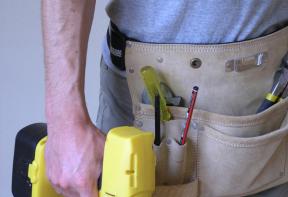25 ways to be a resourceful renovator
Practical tips to reduce your eco-footprint
You recycle, you buy local food when you can and maybe you bike to work on occasion. But how do your homebuilding and renovating practices rate on the eco-meter? With these tips, you’ll be able to increase the health of your living space-your immediate home and the planet.
1 Save water by installing a water-efficient 6-l toilet or a dual-flush model that lets you select the amount of water needed. Low-flow showerheads will also conserve water and still give you a good rinse.
2 Choose low- or zero-volatile organic compounds (VOC)-emitting paints for both interior and exterior applications.
3 Hard surfaces in urban yards increase rainwater runoff, which taxes municipal water-treatment facilities and possibly concentrates toxins in streams, rivers and lakes. Consider permeable paving surfaces that allow turf to grow but can be driven on.
4 Use Forest Stewardship Council (FSC)-certified wood products wherever you can. Engineered products, such as MDF and particleboard, are all available from FSCcertified manufacturers.
5 Choose sustainable sheet goods for cabinetry, wall panelling or furniture. Varieties available include panels made from sustainably grown and harvested bamboo, straw, wheat, coconut palm and sorghum stalks.
6 Wherever stone is called for, use eco-friendly options. Countertops or tiles made from recycled glass terrazzo, paper pressed in resin made from cashew shells and cement products incorporating recycled paper and fly ash are all durable, handsome solid surfaces.
7 Consider green flooring options. From FSC-certified wood and engineered wood products to natural wool carpets with no-VOC backings, bamboo-strip flooring to all-natural linoleum, there’s a flooring solution to fit any decor and lighten your ecological footprint.
8 Don’t send paint down the drain. Clean brushes and rollers in buckets and dispose of the solids after the solvent evaporates. Let unused paint harden before disposal at your local hazardous-waste depot, if possible, or bring it to a paint recycle centre.
9 While a high-efficiency furnace is an expensive investment, it will typically pay for itself after a few seasons in utility-bill savings. If you’re going to use a non-renewable resource, you might as well squeeze all the heat out that you can. Automatic thermostats save energy by lowering the heat when it’s not necessary.
10 Insulate. Proper in-stallation of insulation can reduce energy use substantially. Consider cotton insulation batts made from recycled denim, recycled cellulose insulation, soy-based spray foam or formaldehyde-free fibreglass batts, such as Ultratouch cotton insulation.
11 Separate your construction debris for proper recycling. Clean wood and drywall are completely recyclable, so try to make sure the scraps don’t end up in the landfill. Even pulled nails can be recycled.
12 The 100-mile diet can work for the house too. Locally manufactured or sourced products, such as lumber and stone, don’t require long-distance transportation as internationally sourced products might. Buy locally when you can.
13 Purchase Energy Star-rated appliances to reduce your carbon footprint and also your monthly utility bills.
14 Energy Star-rated windows will keep the cold out in the winter and the heat out in the summer. Simply installing sun-blocking window films or insulating drapery can boost the energy performance of old windows.
15 Install an efficient ceiling fan. It can reduce the demand on the furnace in the winter and air conditioner in summer by promoting air circulation.
16 Compact fluorescent and LED light bulbs are becoming available in a much wider assortment, including CFLs designed for trendy pot lights and dimmable CFLs and LED bulbs, which use tiny amounts of electricity.
17 Green up your yard. Drought-resistant grasses, wildflowers and trees lessen the urban heat island effect, contribute to better air quality and are much less toxic than a backyard covered in asphalt.
18 Watch out for adhesives that give off VOCs. There are low- and zero-VOC construction adhesives, as well as tile and flooring adhesives available, such as Titebond GREENchoice construction adhesive.
19 Explore alternative off-the-grid energy sources, such as photovoltaic electricity generation or geothermal heat, for providing power or heat to your cottage or house.
20 Get an energy audit before your renovation to pinpoint how you can improve your home’s efficiency most effectively.
21 Tiles made from recycled glass are both durable and beautiful.
22 Install an on-demand water heater. By eliminating the large tank of water that is continuously kept hot, you will reduce the amount of gas or electricity you use.
23 Insulate a standard hot-water tank and the water pipes that lead to and from it. The insulation can reduce how often the tank has to switch on to heat water.
24 Composite lumber for decking and other applications is made from recycled wood and plastic and can typically be recycled as well.
25 Keep the rain out of the house and the recyclables out of the landfill. There are a number of engineered roofing products that incorporate recycled plastics or rubber tires to emulate cedar shakes or slate roofing.
To leave a comment, please log in












No comments